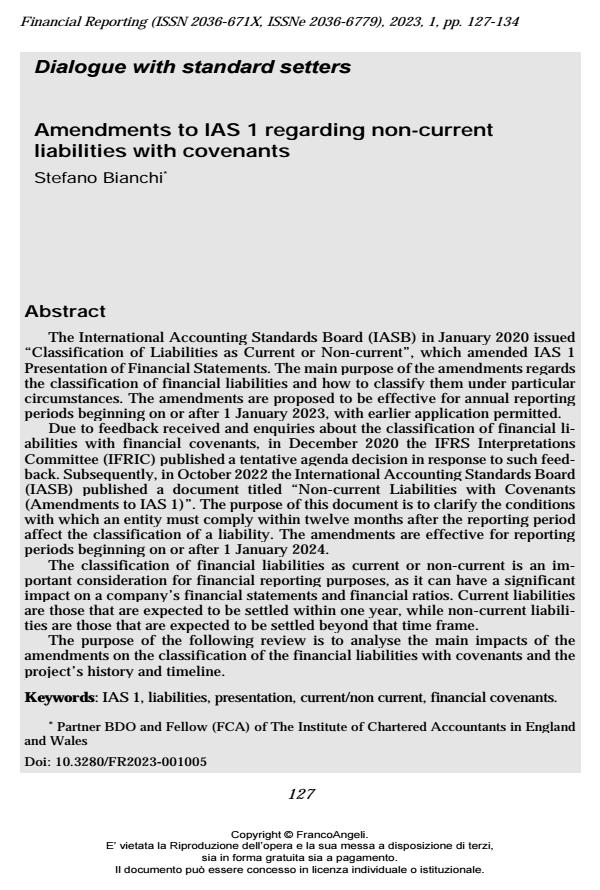Dialogue with standard setters. Amendments to IAS 1 regarding non-current liabilities with covenants
Titolo Rivista FINANCIAL REPORTING
Autori/Curatori Stefano Bianchi
Anno di pubblicazione 2023 Fascicolo 2023/1
Lingua Inglese Numero pagine 8 P. 127-134 Dimensione file 87 KB
DOI 10.3280/FR2023-001005
Il DOI è il codice a barre della proprietà intellettuale: per saperne di più
clicca qui
Qui sotto puoi vedere in anteprima la prima pagina di questo articolo.
Se questo articolo ti interessa, lo puoi acquistare (e scaricare in formato pdf) seguendo le facili indicazioni per acquistare il download credit. Acquista Download Credits per scaricare questo Articolo in formato PDF

FrancoAngeli è membro della Publishers International Linking Association, Inc (PILA)associazione indipendente e non profit per facilitare (attraverso i servizi tecnologici implementati da CrossRef.org) l’accesso degli studiosi ai contenuti digitali nelle pubblicazioni professionali e scientifiche
The International Accounting Standards Board (IASB) in January 2020 is-sued “Classification of Liabilities as Current or Non-current”, which amended IAS 1 Presentation of Financial Statements. The main purpose of the amend-ments regards the classification of financial liabilities and how to classify them under particular circumstances. The amendments are proposed to be effective for annual reporting periods beginning on or after 1 January 2023, with earlier application permitted. Due to feedback received and enquiries about the classification of financial liabilities with financial covenants, in December 2020 the IFRS Interpretations Committee (IFRIC) published a tentative agenda decision in response to such feedback. Subsequently, in October 2022 the International Accounting Stand-ards Board (IASB) published a document titled “Non-current Liabilities with Covenants (Amendments to IAS 1)”. The purpose of this document is to clarify the conditions with which an entity must comply within twelve months after the reporting period affect the classification of a liability. The amendments are ef-fective for reporting periods beginning on or after 1 January 2024. The classification of financial liabilities as current or non-current is an im-portant consideration for financial reporting purposes, as it can have a significant impact on a company’s financial statements and financial ratios. Current liabili-ties are those that are expected to be settled within one year, while non-current liabilities are those that are expected to be settled beyond that time frame. The purpose of the following review is to analyse the main impacts of the amendments on the classification of the financial liabilities with covenants and the project’s history and timeline.
Parole chiave:IAS 1, liabilities, presentation, current/non current, financial cove-nants
Stefano Bianchi, Dialogue with standard setters. Amendments to IAS 1 regarding non-current liabilities with covenants in "FINANCIAL REPORTING" 1/2023, pp 127-134, DOI: 10.3280/FR2023-001005